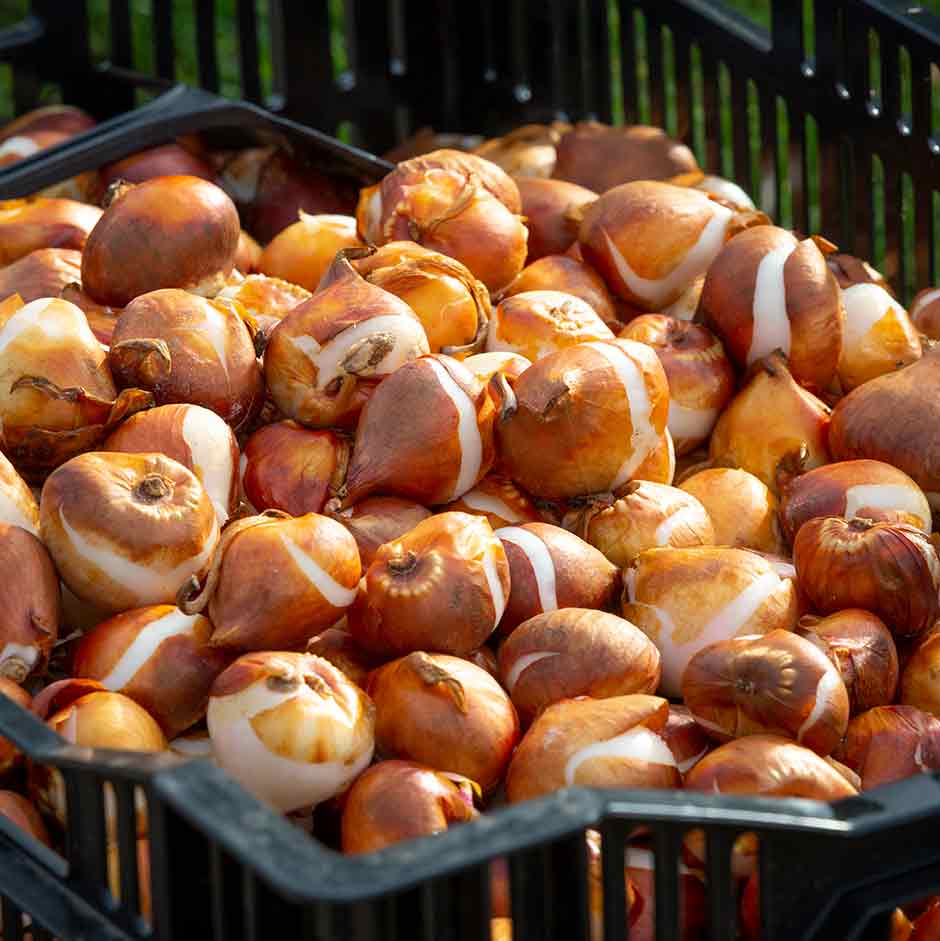Bulbs: planting
Bulbs make a fine display planted in containers or borders, especially daffodils, snowdrops and tulips in spring. They are one of the easiest and most rewarding garden plants to grow.

Quick facts
Difficulty Easy
Suitable for...
Bulbs are useful for adding colour to spring borders. Tulips come in all shades, from dark purple to white, and bloom at a time of year when many plants offer muted colours. Other bulbs, such as snowdrops and scillas, are some of the earliest flowering plants in the garden, brightening up the short days of very early spring.
Planting summer-flowering
Autumn-flowering bulbs, such as nerines, can brighten up the late season with unexpectedly colourful displays.
When to plant bulbs
Autumn
- Plant spring-flowering bulbs, such as daffodils, crocus and hyacinths, preferably by the end of September
- Plant tulips in November
- Plant hardy summer-flowering bulbs, such as lilies, alliums and crocosmia, in September and October
Spring
- Plant tender summer-flowering bulbs, including gladioli, in early spring
Summer
- Plant autumn-flowering bulbs, such as nerines, by late summer
Where to plant bulbs
Some bulbs need specific siting;
- Most hardy bulbs, including tulips and daffodils, prefer a warm, sunny site with good drainage as they come from areas with dry summer climates
- Bulbs from cool, moist, woodland habitats, such as Cardiocrinum, need similar garden conditions. Improve light or sandy soils with garden compost and heavy soils with compost plus grit
How to plant bulbs
Most bulbs are acquired and planted when dry, in a dormant, leafless, rootless state. Plant as soon as possible. They may flower poorly following later than recommended planting or after lengthy storage (see Problem section for more detail).
Planting in borders
Aim to plant in groups of at least six, as the more bulbs that are grouped together, the better the display. Typically, 25 to 50 bulbs may be needed to make an impressive show.
This method applies to spring-, summer- and autumn-flowering bulbs:
- Dig a hole wide and deep enough for your bulbs. Plant most bulbs at two to three times their depth. For example, for a bulb measuring 5cm (2in) high, dig a hole 10-15cm (4-6in) deep and sit the bulb in the bottom of it
- Place the bulbs in the hole with their ‘nose’, or shoot, facing upwards. Space them at least twice the bulb’s own width apart
- Replace the soil and gently firm with the back of a rake. Avoid treading on the soil as this can damage the bulbs
- If the ground is moist or the bulbs are autumn-planted, watering is not critical. Otherwise water straight after planting
Some bulbs, such as winter aconites, bluebells and snowdrops, are thought to be best planted, moved or divided ‘in the green’, when flowering is over but they are still in leaf. However, dried bulbs are often offered and can be successful.
In containers
Most bulbs are ideal for growing in containers, but this especially suits those with large, showy flowers, such as tulips, lilies, arum lilies and alliums. Here are some tips for success:
- For bulbs that are only going to spend one season in their container, use a mix of three parts multi-purpose compost with one part grit. For long-term container displays, use three parts John Innes No 2 compost mixed with one part grit
- Plant at three times their depth and one bulb width apart
- Water bulbs once after planting then regularly when in active growth, but you can reduce watering once the leaves start to die down and then through the dormant season. However, continue to check pots in winter, ensuring they do not dry out completely
- To promote good flowering next year, feed the bulbs every seven to ten days with a high-potassium fertiliser such as a liquid tomato feed. Begin feeding as soon as shoots appear, and stop feeding once the foliage starts to die down at the end of the season
- If you bring pots of hardy bulbs indoors during flowering, put them in a sheltered spot outside as soon as flowering is over
Problems
There aren’t many problems to watch out for, apart from checking that the bulbs are healthy to start with (discarding any that are soft or show signs of rot). However, pests to look our for include slugs, snails, squirrels (particularly with tulips and crocus) and diseases such as daffodil viruses, grey mould in snowdrops, narcissus basal rot, tulip fire and tulip viruses.
Missed planting your bulbs at the right time?
It's easy to forget about bulbs, lost at the back of the shed or in the boot of the car. Or perhaps circumstances meant you weren't able to get them planted when you should have. If that's the case then the best thing to do is get them in the ground or potted up as soon as you can. If you leave them until the autumn or correct time, they'll simply have deteriorated further.
Of course, discard any that are soft or rotten first but the remainder are worth a go, even if they have started to sprout. Some bulbs store longer than others (tulip compared to daffodil, for instance) so it will be a bit hit and miss. If you are relying on a display maybe top up with potted bulbs from the garden centre.
You might also find they don't perform as expected in their first year - short flower stalks for example - but if they're a type of bulb that comes back year after year they should get better in subsequent years. Try adding a well-balanced fertiliser into the soil at planting time to help them recover.
See also...
Get involved
The Royal Horticultural Society is the UK’s leading gardening charity. We aim to enrich everyone’s life through plants, and make the UK a greener and more beautiful place.